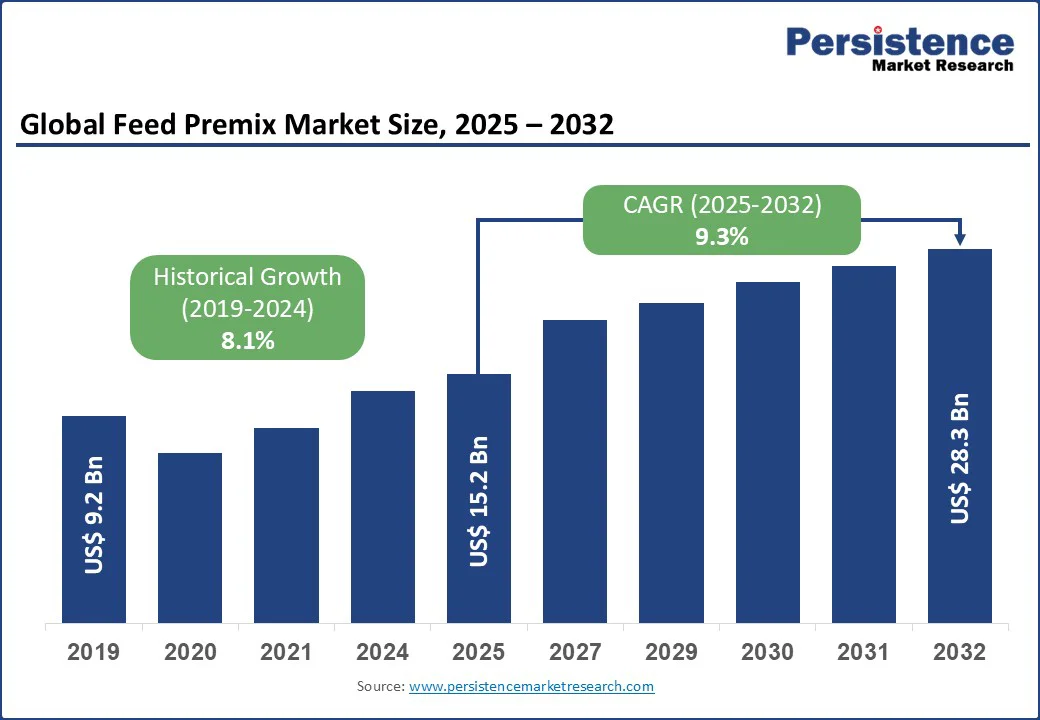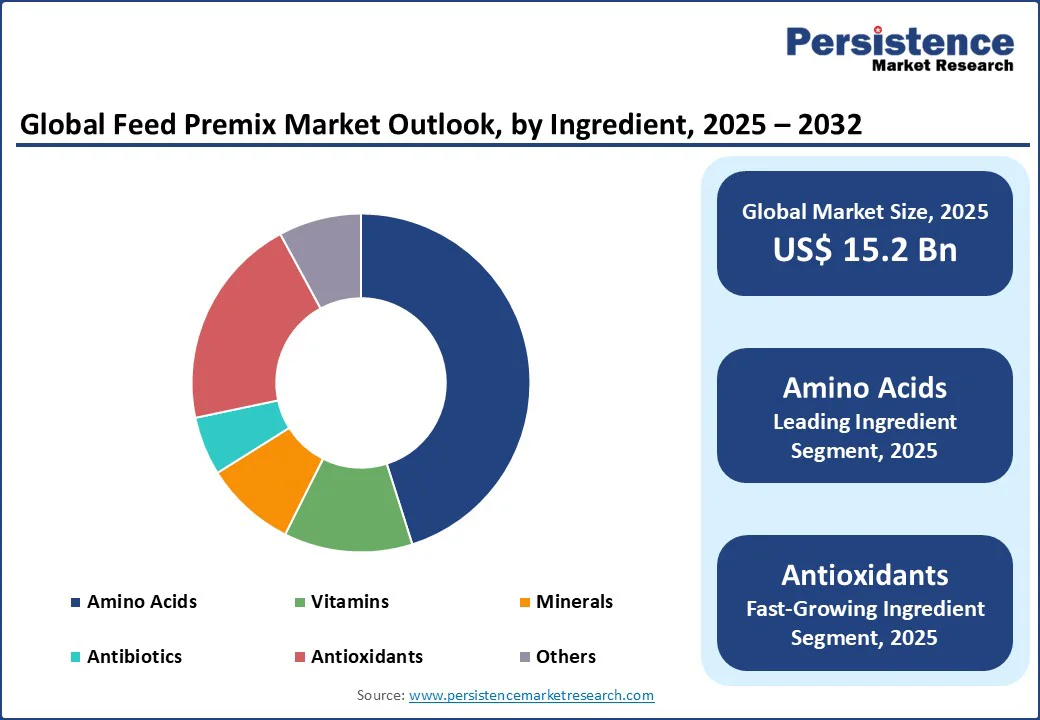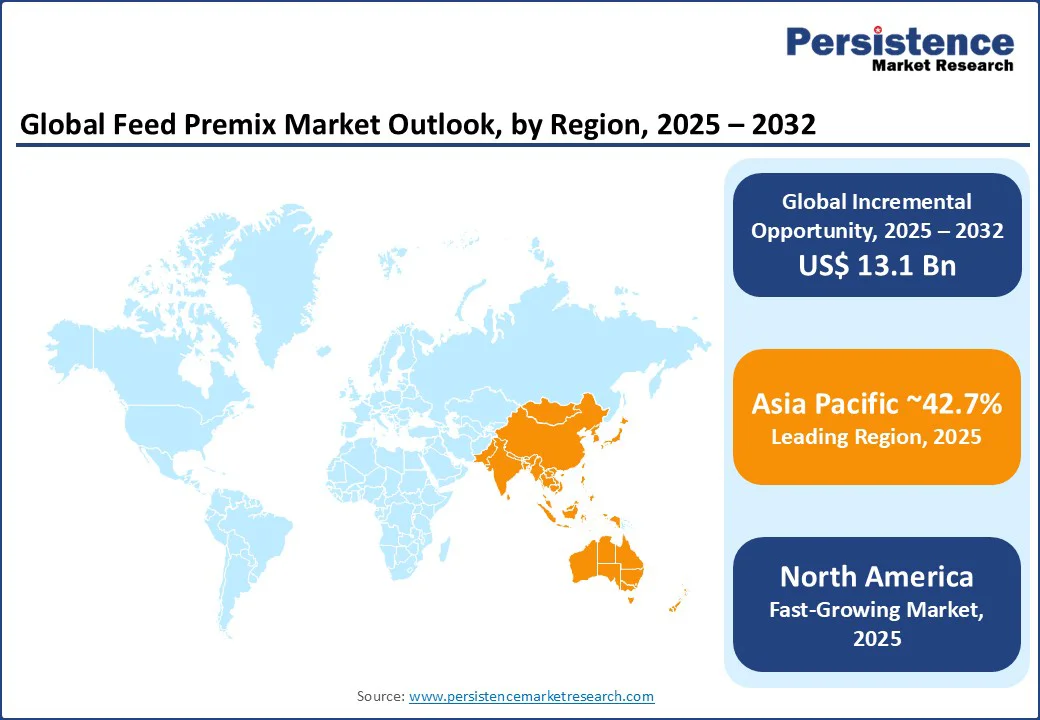ID: PMRREP25441| 197 Pages | 2 Sep 2025 | Format: PDF, Excel, PPT* | Food and Beverages

The feed premix market size is likely to be valued at US$ 15.2 Bn in 2025 and is estimated to reach US$ 28.3 Bn in 2032, growing at a CAGR of 9.3% during the forecast period 2025 - 2032.
The feed premix market growth is being pushed by rising demand for high-quality animal protein, strict regulatory standards, and a surging focus on sustainable farming practices. Companies are embracing development in amino acids, vitamins, minerals, and functional additives to improve feed efficiency, support animal health, and reduce environmental impact. To remain competitive, they are investing in research and development for customized formulations as well as antibiotic-free alternatives.
Key Industry Highlights

|
Global Market Attribute |
Key Insights |
|
Feed Premix Market Size (2025E) |
US$ 15.2 Bn |
|
Market Value Forecast (2032F) |
US$ 28.3 Bn |
|
Projected Growth (CAGR 2025 to 2032) |
9.3% |
|
Historical Market Growth (CAGR 2019 to 2024) |
8.1% |
The rising demand for livestock-based products is changing how farmers approach feed formulations. Premixes have become important for meeting both production efficiency and quality standards. As consumers seek high volumes of meat, milk, and eggs, farmers are under pressure to accelerate growth rates and improve feed conversion ratios. Premixes that integrate essential amino acids, vitamins, and trace minerals allow livestock to reach market weight quickly without excessive feed use.
In India, for example, the surging poultry meat consumption has encouraged integrators such as Suguna Foods to adopt premixes that optimize protein utilization. It helps in ensuring birds meet weight targets while keeping costs manageable.
The shift in consumer expectations toward safe and nutrient-rich animal products is also augmenting premix adoption. Europe-based dairy producers, for instance, are using premixes fortified with selenium and vitamin E to refine the antioxidant profile of milk. This is not just about boosting yield but about differentiating products in a competitive market.
The ban on antibiotics in livestock feed is creating new challenges for manufacturers. Antibiotics were traditionally used not just to prevent disease but to improve growth rates and feed efficiency. Without them, premix manufacturers must reformulate products to include alternative growth promoters, immune enhancers, and gut-health additives. This shift increases research and development costs and complicates supply chains as sourcing effective natural additives is expensive.
Regulatory compliance also adds pressure. Premix producers must face a patchwork of rules that differ by country, making it costly to standardize products for multi-country distribution. For instance, in the U.S., certain ionophores are still allowed as coccidiostats, whereas the EU bans them completely.
Firms exporting premixes must reformulate to comply with both domestic and international rules, increasing production complexity. Also, antibiotic-free premixes often require precise nutrient balancing and customized formulations for specific species or life stages, increasing customization demands.
The steadily expanding milk production capacity is creating a new opportunity for feed premix manufacturers as dairy farms rely on precision nutrition to maximize yield and maintain animal health. Modern dairy cows require finely balanced diets to sustain high milk output without compromising reproductive performance or immune function. Premixes enriched with amino acids, minerals, and vitamins help improve protein utilization and prevent deficiencies that can reduce milk quality.
Another growth opportunity arises from the shift toward premium and fortified milk products. Modern consumers are demanding high-quality milk infused with omega-3 fatty acids, vitamins, or minerals. Hence, dairy integrators are turning to feed premixes as a direct tool to influence the nutritional profile of milk. In India, leading dairy cooperatives have started incorporating selenium- and vitamin E-enriched premixes to improve antioxidant levels in milk.
By ingredient, the market is segregated into amino acids, vitamins, minerals, antibiotics, antioxidants, and others. Among these, the amino acids segment is poised to hold around 45.1% share in 2025 as they directly influence protein synthesis and growth efficiency in livestock, which no other additive group matches as effectively.
Amino acids are the building blocks of muscle tissue, enzymes, and hormones. When diets rely heavily on cereals and plant-based proteins, they often fall short in essential amino acids such as lysine, methionine, or threonine. Premixes fill this gap precisely, improving feed conversion and reducing the requirement for crude protein.
Antioxidants are seeing considerable growth as livestock diets have become rich in energy-dense ingredients and fats, which oxidize quickly and compromise feed quality. Once oxidation sets in, vitamins such as A and E degrade, fatty acids turn rancid, and the feed loses both palatability and nutritional value. Premixes fortified with antioxidants delay this breakdown, helping integrators protect feed shelf life in large-scale operations where storage and transport cycles are longer.
Based on species, the market is divided into pet, poultry, ruminant, swine, aquaculture, and others. Out of these, the poultry segment is speculated to account for nearly 40.5% of share in 2025 as chickens convert feed to meat faster than cattle or swine.
Hence, producers are quick to adopt premixes that optimize amino acid balance, vitamin density, and gut health. This efficiency becomes essential as global quick-service restaurant chains expand in Asia Pacific and the Middle East, where poultry remains the most affordable protein.
Swine is considered a key species because pigs have complex nutritional requirements that cannot be met by standard feed ingredients alone. Swine cannot synthesize certain essential amino acids and hence premixes rich in lysine, threonine, and tryptophan are important for efficient growth and lean meat production. Feed premixes also help in reducing the crude protein levels in diets while still meeting performance goals. It supports cost savings and lowers nitrogen emissions.

In 2025, Asia Pacific is anticipated to account for approximately 42.7% of share due to the ongoing shift toward organic and antibiotic-free premixes. Consumers are now demanding clean meat and dairy products, and farmers and feed manufacturers are responding.
For instance, surging bans on antibiotic additives and a preference for organic feed are prompting producers to launch blend-based premixes loaded with probiotics and natural extracts. Heavily industrialized livestock systems are pushing demand for high-performance premixes in China.
Swine, poultry, and dairy sectors are being propelled by food safety policies and broadcast efforts to curb antibiotic usage. China-based amino acid producers are getting a boost as soy dependency drops and methionine supplementation climbs.
In India, growth is being bolstered by enormous livestock base and increasing egg and poultry production. Custom premixes are becoming essential for broiler growth and egg yield optimization. The Philippines and Vietnam are emerging as key hubs with the rise of layer feed production.
Customization of feed premixes is becoming increasingly important in North America with formulations made for specific animal species and production goals. The swine feed premix segment, for example, is predicted to rise steadily owing to high meat demand and ongoing developments in nutritional research.
This expansion will likely result in the emergence of customized feed premixes that target specific farm requirements, including improved additives for maintaining animal health and climate-specific formulations.
The U.S. feed premix market is poised to dominate as the dry form of feed premixes continues to witness increasing demand. This is mainly attributed to its ease of handling, long shelf life, and cost-effectiveness in large-scale animal feed production.
There is, however, a surging interest in liquid and pellet forms, specifically in specialized applications where precision and rapid absorption are important. Technological developments in feed processing are enabling efficient production of these alternative forms.
In Europe, demand is being accelerated by policy and safety. Regulators and industry targets are pushing down antibiotic use. Hence, premix makers now sell more probiotics, phytogenics, and mycotoxin binders as direct replacements or risk-mitigation tools. EU surveillance data show a clear fall in antimicrobial sales for farmed animals. Industry groups are building roadmaps that nudge premix portfolios toward non-antibiotic solutions.
Weather volatility and rising mycotoxin risk are changing formulation choices. Wet springs and late rain in parts of Europe have driven year-on-year spikes in mycotoxin detection in cereal samples. The trend enables premix buyers to add mycotoxin-deactivators and multi-mode toxin management into standard blends rather than treating those ingredients as niche add-ons.
In Germany, premix buyers demand traceability and welfare-linked claims, mainly for pig and poultry chains. Hence, local feed additive suppliers and big integrators are pushing complex vitamin-enzyme-phytogenic blends into mainstream rations.

The feed premix market is characterized by global conglomerates, regional specialists, and emerging local players. Global giants dominate due to their ability to invest in research, provide wide product portfolios, and ensure consistent supply across multiple markets.
They differentiate themselves through developments such as amino-acid optimization, enzyme and probiotic integration, and sustainability-oriented premixes. Regional players often compete by delivering cost-effective solutions made for local livestock. They focus on phytogenic additives and mycotoxin management, which cater to regional feeding challenges and regulatory frameworks.
The feed premix market is projected to reach US$ 15.2 Bn in 2025.
Rising demand for high-quality animal protein and surging focus on livestock health are the key market drivers.
The feed premix market is poised to witness a CAGR of 9.3% from 2025 to 2032.
Emergence of sustainability-focused products and expansion in emerging countries are the key market opportunities.
Cargill, Inc., ADM, and DLG are a few key market players.
|
Report Attribute |
Details |
|
Historical Data/Actuals |
2019 - 2024 |
|
Forecast Period |
2025 - 2032 |
|
Market Analysis |
Value: US$ Bn/Mn, Volume: As Applicable |
|
Geographical Coverage |
|
|
Segmental Coverage |
|
|
Competitive Analysis |
|
|
Report Highlights |
|
|
Customization and Pricing |
Available upon request |
By Product Type
By Ingredient
By Species
By Region
Delivery Timelines
For more information on this report and its delivery timelines please get in touch with our sales team.
About Author